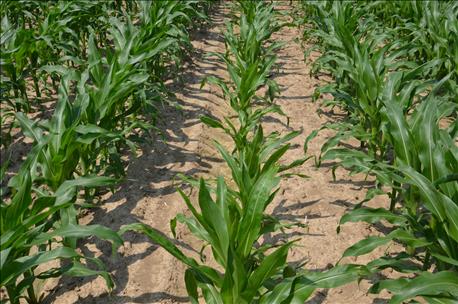
Nobody was more anxious to plant than I was helping my dad on the farm during my college years and after I began my career. Our soils weren‘t well drained and it was a struggle to get planted on time, but I was convinced we needed to plant earlier to get better yields.
We finally did figure out how to get better yields. But in the process, we first tried out several so-called truths that turned out to be little more than myths in disguise. Call it misguided wisdom of the day if you want. It was the 1980’s. What we wound up with until we woke up was a lot of tall corn and short corn, the hallmark of soil compaction.
Here are 5 myths disguised as half- truths you might want to avoid.

A REALITY, NOT A MYTH! Tall corn, short corn and uneven rows caused by soil compaction patterns is the one thing in this story that is 100% real!
1. You can plow in the fall when it’s wet and winter will take care of it!
Guilty as charged! I spent one Thanksgiving Day around 1980 plowing with an Allis-Chalmers 190 and moldboard plow, with the tires spinning once in a while. I can plead ignorance- I didn’t know any better. Now I do. Freezing and thawing does not take care of the sins of the fall.
2. Let’s disk the soil to dry it out!
If anyone still believes that, they need a lesson in soil physics. I bought it at the time. It appeared to dry out on top if we disked it, knowing it was a bit wet, but we thought it would help if we ‘opened up’ the crust on conventionally tilled fields. What we didn’t know was that 80% or more of the damage from driving over a field is done on the first pass.
3. Work around the wet spots and plant the rest.
If the wet spots are something short of wet holes that stay wet almost all year, this practice is an exercise in futility. If several pockets in the field are too wet, the field is likely all on the tacky side. When you’re itching to get going, I know from experience you can justify almost anything to get started. Corn roots don’t know what you justified when they hit hard layers and go sideways, and can’t get down to moisture if it turns dry.
4. It’s a bit tacky, but I will plant anyway!
Those famous words sound prophetic if it rains after you plant and keeps raining a half-inch every week all summer. If you don’t live in such a fairy-tale world as that, then the prophesy can become more like a curse. Compacted soils, especially if there is compaction in the seed slot early, can set the stage for trouble if it’s a dry year.
5. A cultipacker will take care of clods and they won’t be an issue
If you still have one and it’s parked in the back of the shed, you might want to leave it there. Dad bought one in a spring when he had plowed too wet. It was one time mom was justified in complaining about his tendency to make impulsive purchases. Smashing clods may have made him feel better, but it didn’t make the corn in the part of the field that had been the cloddiest any greener that summer. It’s taken me long enough, but at least I finally figured it out. There are better options than creating soil compaction if you don’t have to do so.
About the Author(s)
You May Also Like




